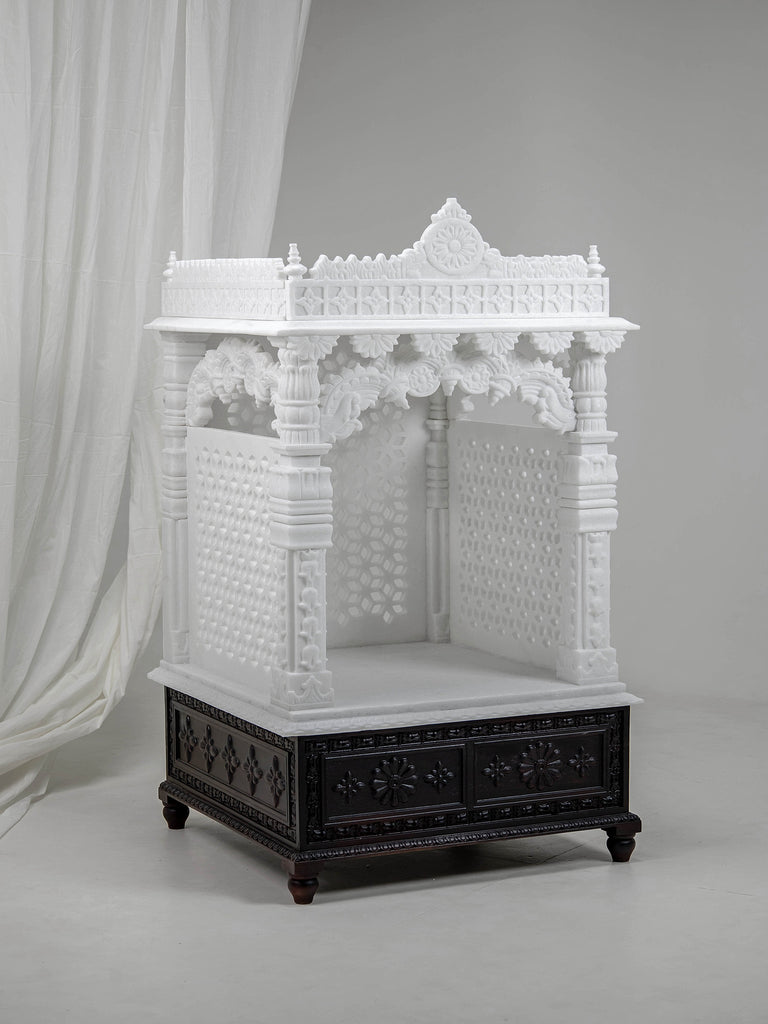When it comes to temple design, grandeur often steals the spotlight. Large, magnificent structures dominate our perception of beauty, while smaller designs tend to be overlooked. Shwet, however, is redefining this narrative through innovative new product development, bridging the gap between the beauty of the grand and the grace of the small. Our commitment to personalization is at the core of our mission – we make small spaces beautiful and focus on personalized home mandirs crafted entirely in Makrana marble. And, this is the story of how we do it.
Our Design Philosophy: Small Sizes, Majestic Designs
Shwet believes in the radiance of beauty at every scale. Graceful Shwet mandirs, with their fine, slender designs, bring elegance to any space, transforming even the simplest corner into a refined puja area. Lighter and more versatile than larger home temples, Shwet's designs easily complement various décor schemes.
Harmony extends to the functional aspects of Shwet mandirs. Features like smoothly opening drawers with flexible sectioning, pre-installed lights enhancing the opalescence of Makrana marble, and discreet hooks for curtains contribute to the overall elegance and ease of use.
For all our temples, we use the Makrana Marble known as the divine stone. Its longevity, purity, and ethereal glow make it the ideal choice for sacred spaces. Recognized as Asia's first Global Heritage Stone Resource (GHSR), Makrana marble recently received acknowledgment from the International Union of Geological Sciences.
Shwet's Ustajis, master artisans rooted in Makrana for centuries, bring divine artistry to life. Their ability to draw out the fine glow within the stone makes them masters of light. Mandirs crafted by these artisans, regarded with fascination across the globe, are expressions of the sacred, destined to be cherished through generations.
How We Use Personalisation To Transform Compact Spaces
Personalized
The personalized collection allows for nuanced modifications, catering to individual preferences and spatial requirements. Adjustments in measurements ensure a precise fit in any nook or alcove, transforming spaces into beautiful puja areas. Personal touches extend to the design itself, enabling emphasis on a particular deity or symbol.
Why Personalisation Matters
1. Adjust the Dimensions: Even slight alterations can make a substantial difference, ensuring seamless integration with the home aesthetic.
2. Choose or Remove the Back Panel: Tailoring the back panel refines the mandir's meaning and beauty, allowing for personalization with symbols or mantras.
3. Alter the Base: Customizing the base aligns the mandir with home décor, offering options like wooden bases or drawers to suit individual preferences.
For those inclined towards personalization, Shwet welcomes inquiries to explore the possibilities of tailored designs. Additionally, Shwet offers a completely bespoke design service, allowing patrons to specify exact requirements and preferences.
In essence, Shwet's endeavor to make small spaces beautiful through personalized, Makrana marble home mandirs not only revives ancient principles but also exemplifies a harmonious blend of tradition and contemporary living. The integration of Vastu and Shilpa Shastras adds a profound layer of spiritual significance, making each mandir a conduit for positive energy and divine harmony.
How We Integrate Ancient Wisdom Into Our Mandirs
Shwet draws inspiration from the grandeur of ancient Indian aesthetics, where beauty was manifested at a grand scale. In particular, the use of Makrana marble, renowned for its ethereal glow, echoes the sacred art of temple design. Shwet's designers adhere to ancient guidelines found in the Shilpa Shastras and Vastu Shastras, ensuring a divine manifestation in every creation.
In fact, our logo, a beautiful white peacock, expresses this. Its gaze is set to the north east, contemplating the Vastu of the temple, while its feet are placed inside the auspicious chhokhat. The lamp-like ‘t’ symbolizes both the flame of the law and the lamps integral to puja ritual.
The incorporation of Vastu and Shilpa Shastras in Shwet's temple designs is a harmonious marriage of ancient wisdom and modern aesthetics. These shastras provide precise instructions for every detail, from the elegant proportions of the building to the refined mathematical curve of patterns and carvings.
Cosmic Orientation: According to Vastu Shastras, the orientation of a temple is paramount. The main entrance, typically facing north-east, opens the space to positive cosmic energies. The placement of the deity within the inner sanctum aligns with specific directions associated with various deities, fostering a harmonious connection.
Mandala Design: The use of mandalas, geometric designs symbolizing the cosmos, is a common prescription in Vastu Shastras. Shwet adheres to this wisdom, employing square or rectangle mandalas divided into smaller squares, each representing a deity or aspect of divinity. The alignment and proportions maintain cosmic harmony within the sacred space.
Agama Shastras: A subset of Vastu Shastras, the Agama Shastras provide specific guidelines for temple rituals, ceremonies, and deity consecration. These texts detail the proportions of the sanctum, the materials to be used, and the rituals to infuse divine energy into the temple, ensuring a sacred atmosphere.
Sacred Geometry: Emphasizing sacred geometry, Vastu Shastras prescribe specific ratios and proportions in temple construction. For instance, the ratio of the height of the sanctum to its width is carefully calculated, ensuring aesthetic appeal and spiritual significance.
Read More about how we align our temples with Vastu & Shipla Shastras, here.

















